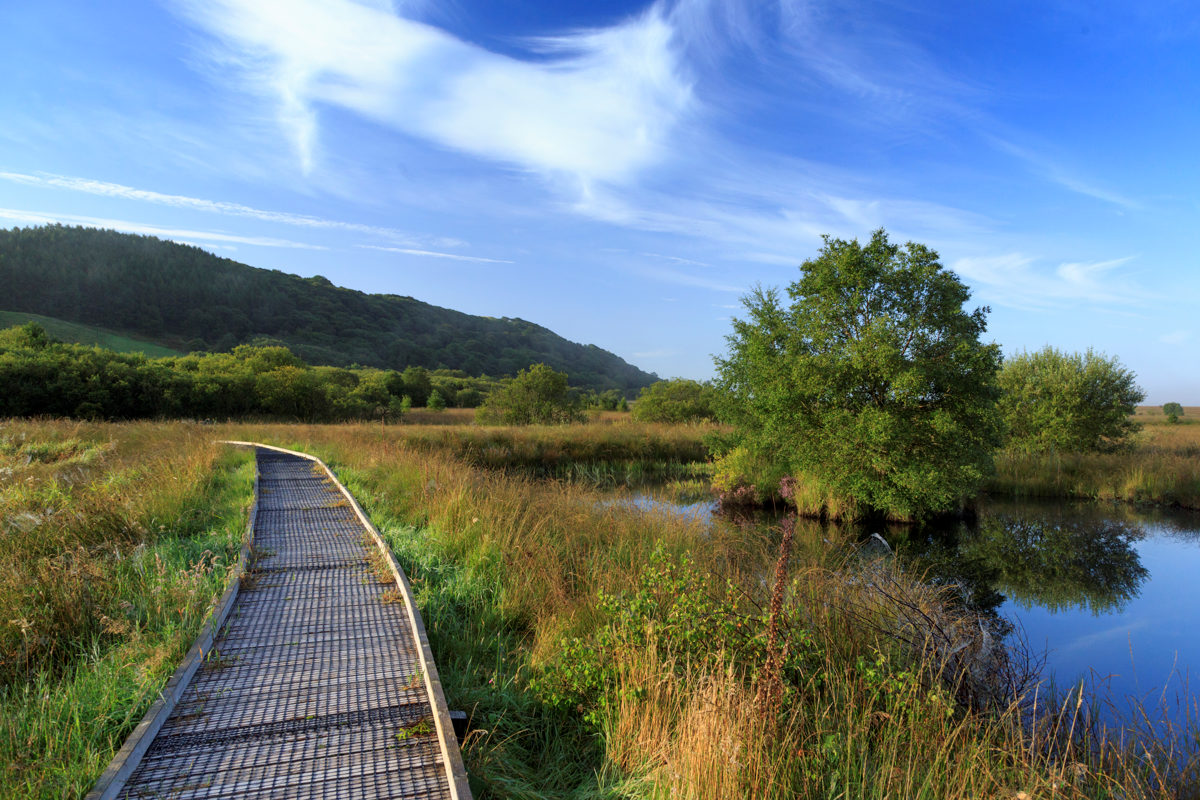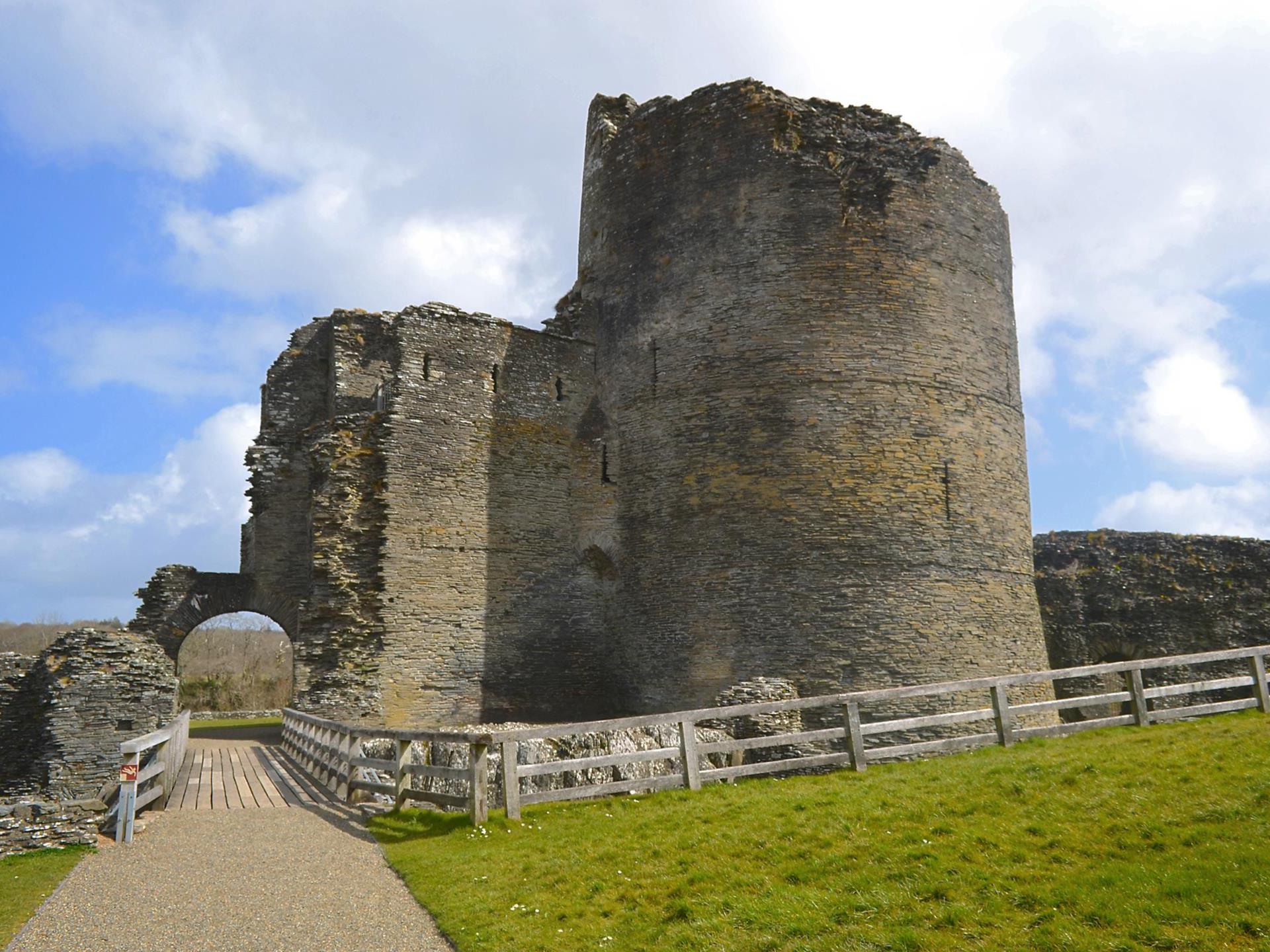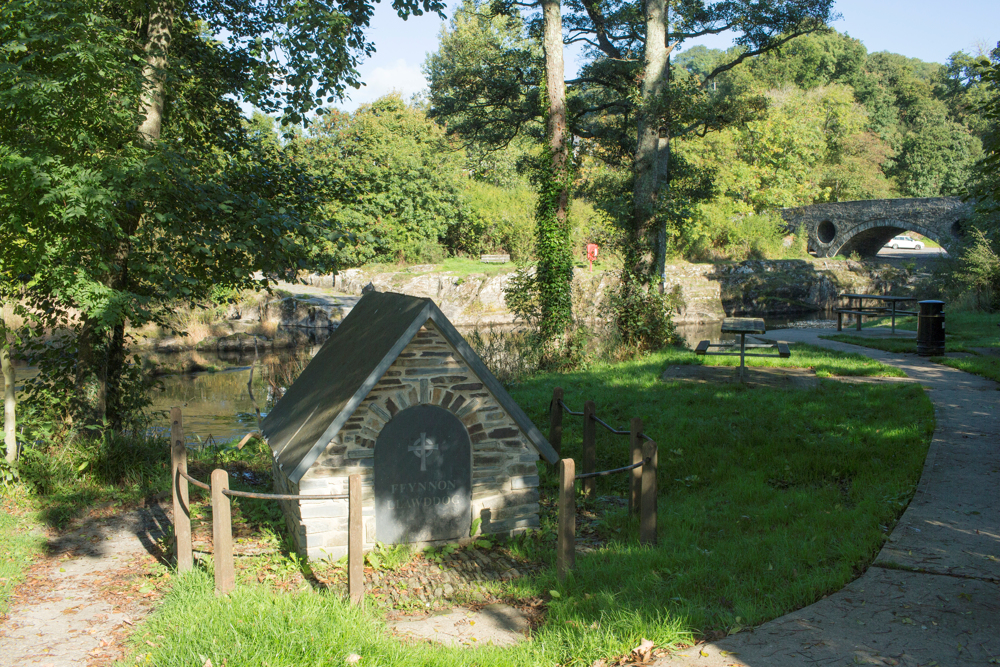The river Teifi rises at Teifi Pools, a collection of glacial lakes that lie at about 1,500 ft (455 meters) above sea level, are deep enough to be believed to be unfathomable. the lakes - Llyn Teifi, Llyn Hir, Llyn Gorlan, and Llyn Egnant were famous even in medieval times for the quality of their eel and trout fishing.

The river Teifi, at 75 miles (122km) in length, is the longest river that flows from source to sea wholly within Wales. However, there's evidence that suggests that it was once even longer, extending at least a dozen more miles to the north, but the Teifi's headwaters were 'stolen' by the river Ystwyth, as it gradually lengthened its course inland, capturing a length of the Teifi from Pontrhydygroes.
The special landscapes of the Teifi
Most of the Teifi and its tributaries are designated a Special Area of Conservation. The three raised bogs of the Cors Caron National Nature Reserve, at just over 2,000 acres, fill the valley of the upper Teifi river between Tregaron and Pontrhydfendigaid. One of the finest examples of raised peat bogs in lowland Britain, Cors Caron is recognised internationally as an important wetland and is a designated National Nature Reserve and an international RAMSAR wetland site. 
Cors Caron is also known as Cors Goch Glanteifi - 'the red bog of the Teifi riverside banks' - for the distinctive red hue of its vegetation - sedges, carpets of sphagnum moss, dotted with the delicate, yellow flowered bog asphodel, flag iris and insect consuming sundew.

This is the habitat of Ceredigion's 'county flower' too - the pretty heather like, bog rosemary (andromeda polifolia). These and other plant materials form the basis of the deep reserves of peat that have built up over the last 12,000 years, forming gentle dome shaped forms, which are still growing behind a glacial moraine, which the river Teifi has breached.
Bog and rhos environments are great for spotting rare butterflies such as the rosy marsh moth and large heath butterfly, as well as pretty dragonflies and damselflies. Look out for signs of shy wetland mammals too - otter, polecat and water voles - and listen to the song of skylarks and meadow pipits. Cors Caron's winter visitors include whooper swans.

Of course, no bog is complete without a bog body. Discovered in 1811, the headless body of an Iron Age man, which may have been from a ritual burial,was re-buried in Ystrad Meurig churchyard. More recent signs of human activity are evident too, from the peat cuttings which were harvested for fuel until the mid 20th century to the railway track of the Manchester Milford railway, built on woolsacks, that now forms the southern end of the Ystwyth trail.
 On the edge of the bog, at Maesllyn (the lake field), a glacial ‘kettle pond’ can be easily seen from the Ystwyth Trail. There are boardwalks that take you out to safely to the middle of the bog, where you'll find a shelter to watch the wildlife.
On the edge of the bog, at Maesllyn (the lake field), a glacial ‘kettle pond’ can be easily seen from the Ystwyth Trail. There are boardwalks that take you out to safely to the middle of the bog, where you'll find a shelter to watch the wildlife.
 There are several other nature reserves along the Teifi, varying from broadleaved woodland slopes to watermeadows and the reed edged estuary flats. Pine marten and red squirrels inhabit the wooded slopes to the east of the Teifi between Tregaron and Lampeter.
There are several other nature reserves along the Teifi, varying from broadleaved woodland slopes to watermeadows and the reed edged estuary flats. Pine marten and red squirrels inhabit the wooded slopes to the east of the Teifi between Tregaron and Lampeter.
The Teifi - renowned fishing river
Anglers, including an American President, travel from all over the world to fish in the Teifi Pools and on the river Teifi itself, a renowned fly-fishing river where the prize catch is trout, salmon and ‘sewin’ (sea trout). There are several angling clubs who manage beats along the Teifi from Tregaron to Llandysul.

At Cenarth, salmon can be seen leaping over the falls, and there are a number of skilled fishermen licensed to fish on the river using coracles - flat bottomed, oval shaped boats constructed from willow and hazel. See coracles being raced at Cenarth and Cilgerran at village festivals in August, or at the annual Cardigan River and Food Festival.
Settlement and industry along the river Teifi
People have lived and worked by the river Teifi since Neolithic times and there are a number of iron age hill forts sited at strategic points along its course. Pen y Bannau hillfort overlooks the ruins of Strata Florida medieval abbey on the upper reaches of the Teifi at Pontrhydfendigaid and there's a series of hillforts between Tregaron and Llandysul, including a number hidden on the wooded ridge of Allt Goch, near Lampeter.

Cardigan castle was the first castle to be built in stone by a Welsh prince whilst Cilgerran castle was built by a Norman lord. Both were captured and recaptured, changing hands several times between the Welsh and the Normans and later, the English.

Mills in the Teifi Valley were at the centre of the Welsh woollen trade in the 19th and early 20th century, employing hundreds of men and women to produce flannel, tweed, quilts and shawls to the coal mining valleys of south Wales and blankets and worsted uniform cloth for the soldiers during World War I.
Rock Mill in the Clettwr valley (a tributary of the Teifi) near Llandysul was built in 1890. Today it is the only working, water powered, commercial woollen mill remaining in Wales. On the confluence of another three tributaries of the Teifi is Drefach Felindre, where among a complex of former mills, is the Welsh National Wool Museum.

Peaceful places of learning, faith and culture
The Cistercian abbey of Strata Florida was a major centre of learning during the Middle Ages, and today the site has a special, peaceful atmosphere.
 The churches and chapels of the Teifi valley are often set on raised ground, such as St Caron at Tregaron, St David's church at Llanddewi Brefi, the whitewashed Llanwenog set in a circular churchyard, or St Cynllo and its elaborate High Victorian decor. St Tysul at Llandysul, sits near the river and has a distinguishing high tower. Spot the carved script on the 'ogham' stone in the churchards of Llanwenog and at Llanllawddog at Cenarth, a stone's throw from the holy well dedicated to the saint.
The churches and chapels of the Teifi valley are often set on raised ground, such as St Caron at Tregaron, St David's church at Llanddewi Brefi, the whitewashed Llanwenog set in a circular churchyard, or St Cynllo and its elaborate High Victorian decor. St Tysul at Llandysul, sits near the river and has a distinguishing high tower. Spot the carved script on the 'ogham' stone in the churchards of Llanwenog and at Llanllawddog at Cenarth, a stone's throw from the holy well dedicated to the saint.
 St David's College (now part of the University of Wales Trinity St David's) at Lampeter was established in 1822 to train Anglican clergymen; The Catholic national shrine of Wales is to be found in a new church dedicated to Our Lady of the Taper at Cardigan.
St David's College (now part of the University of Wales Trinity St David's) at Lampeter was established in 1822 to train Anglican clergymen; The Catholic national shrine of Wales is to be found in a new church dedicated to Our Lady of the Taper at Cardigan.
The Teifi marshes and the Welsh Wildlife Centre
The whole length of the Teifi river and its tributaries have been designated as a Special Area of Conservation. The Teifi marshes on the river's estuary are a Site of Special Scientific Interest (SSSI) and has one of the largest expanses of reedbeds which can be easily explored along a boardwalk.
 The nature reserve is managed by the Wildlife Trust of South and West Wales who also run the Welsh Wildlife Visitor Centre where you can learn more about the reserve and its population of kingfisher, herons, otters and even a herd of water buffalo, which are used to keep pools free of vegetation so that amphibians and insects can also thrive.
The nature reserve is managed by the Wildlife Trust of South and West Wales who also run the Welsh Wildlife Visitor Centre where you can learn more about the reserve and its population of kingfisher, herons, otters and even a herd of water buffalo, which are used to keep pools free of vegetation so that amphibians and insects can also thrive.
The Teifi estuary- from St Dogmaels to the sea
At Gwbert, at the mouth of the river Teifi, the sand dunes, known as Towyn Burrows lie on an ancient bed of glacial till, blown from the Irish Sea by strong onshore winds. The wind and tide can still dramatically change the sand at the mouth of the Teifi between Gwbert on the north shore and and Poppit Sands on the southern side of the estuary.

Find your epic - adventure on the River Teifi
The waters of the Teifi are popular with kayakers and canoeists - from the championship courses through the rapids at Llandysul, or the slower waters below the ramparts of Cilgerran castle.
There are plenty of gentle, quiet country lanes to take your bike out for a run or cycle the Ystwyth Trail, which follows the route of the former railway line between Aberystwyth and Tregaron, along the edge of Cors Caron. There are cycling, walking and running clubs where you can join locals on regular outings, or look out for competitions like the Tregaron 'bog trotter' or triathlon races.

There is also a range of gentler pursuits to choose from: traditional countryside skill or try a craft such as pottery, jewellery, stained glass and painting, or relax with a yoga retreat or walking holiday with Teifi valley tourism businesses.
